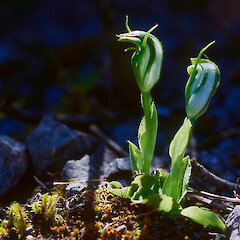Pterostylis foliata
Common name
grassland greenhood
Synonyms
Pterostylis gracilis Nicholls, Pterostylis vereenae R.S.Rogers
Family
Orchidaceae
Flora category
Vascular – Native
Endemic taxon
No
Endemic genus
No
Endemic family
No
Structural class
Orchids
NVS code
The National Vegetation Survey (NVS) Databank is a physical archive and electronic databank containing records of over 94,000 vegetation survey plots - including data from over 19,000 permanent plots. NVS maintains a standard set of species code abbreviations that correspond to standard scientific plant names from the Ngä Tipu o Aotearoa - New Zealand Plants database.
PTEFOL
Chromosome number
2n = 44-46
Current conservation status
The conservation status of all known New Zealand vascular plant taxa at the rank of species and below were reassessed in 2017 using the New Zealand Threat Classification System (NZTCS) – more information about this can be found on the NZTCS website. This report includes a statistical summary and brief notes on changes since 2012 and replaces all previous NZTCS lists for vascular plants.
Please note, threat classifications are often suggested by authors when publications fall between NZTCS assessment periods – an interim threat classification status has not been assessed by the NZTCS panel.
- Conservation status of New Zealand indigenous vascular plants, 2017 . 2018. Peter J. de Lange, Jeremy R. Rolfe, John W. Barkla, Shannel P. Courtney, Paul D. Champion, Leon R. Perrie, Sarah M. Beadel, Kerry A. Ford, Ilse Breitwieser, Ines Schönberger, Rowan Hindmarsh-Walls, Peter B. Heenan and Kate Ladley. Department of Conservation. Source: NZTCS and licensed by DOC for reuse under the Creative Commons Attribution 4.0 International licence.
2017 | At Risk – Naturally Uncommon | Qualifiers: SO, Sp
Previous conservation statuses
2012 | At Risk – Naturally Uncommon | Qualifiers: SO, Sp
2009 | At Risk – Naturally Uncommon
2004 | Not Threatened
Distribution
Indigenous. New Zealand: North Island, South Island. Also Australia
Habitat
Coastal to montane (up to 800 m a s.l.) in grassland, amongst low scrub, within open forest and within plantation forest. Often found growing with the adder’s tongue fern (Ophioglossum coriaceum A.Cunn.).
Detailed description
Terrestrial, tuberous, glabrous, spring to summer-green perennial herb, either solitary or forming small colonies of 3–6 plants through vegetative extension. Plant at flowering 150–400 mm tall. Stem stiffly erect, smooth or sparsely and unevenly puberulent, dark green to yellow green; usually elongating following fruit set; upper internodes usually longer than stem leaves. Basal leaves 2–4, yellow-green to dark green, sessile, arranged in a more or less loose to crowded rosette; lamina up to 80 × 25 mm, elliptic, margins smooth, crisped or undulose, apex subacute, gradually narrowed into a short, winged petiole. Cauline leaves 1–2, yellow-green to green, 20–30 mm long, more or less foliaceous, closely sheathing, uppermost sometimes reaching but scarcely overtopping flower. Flower solitary, erect, white with broad green to greenish-brown stripes, often brown toward the apex. Ovary erect, papillose. Dorsal sepal 20–30 × 20 mm long, erect for ⅔ of length then curving forwards, apex acute and more or less horizontal, extending no further than petals. Lateral sepals closely embracing galea, papillose on the fused portion, sinus narrow, not protruding, diverging at a narrow angle, tips caudate up to 18 mm long and overtopping galea. Petals only a littler shorter than dorsal sepal, broad almost to apex. Labellum dark green above and paler beneath, protruding, narrow-triangular, arched, tapering to a narrowly obtuse apex, margins slightly upturned. Column shorter than labellum; stigma elliptic, more or less prominent.
Manaaki Whenua Online Interactive Key
Similar taxa
None. The yellow-green to dark green plants, with their stiffly erect stems bearing closely sheathing bract like leaves; basal leaves which are arranged in a loose rosette, and usually with crisped or wavy margins; and small, erect brownish flowers readily distinguish this species from all other indigenous Pterostylis species.
Flowering
October–December
Flower colours
Brown, Green
Fruiting
December–April
Propagation technique
Difficult—should not be removed from the wild. Basic orchid mix consists of 2 parts medium coarse sand, ideally clean river sand; 2 parts soil, humus or leaf-mould; 1 part weathered sawdust or rotting wood; 1 part granulated bark. For Pterostylis shade of 50% and pots kept evenly moist.
Etymology
pterostylis: Winged column
foliata: Leafy
Where To Buy
Not commercially available
Attribution
Fact Sheet prepared for NZPCN by P.J. de Lange 14 April 2007: Description adapted from Moore and Edgar (1970).
References and further reading
Moore LB, Edgar E. 1970. Flora of New Zealand, Volume II. Indigenous Tracheophyta: Monocotyledones except Gramineae. Government Printer, Wellington, NZ. 354 p.
NZPCN Fact Sheet citation
Please cite as: de Lange, P.J. (Year at time of access): Pterostylis foliata Fact Sheet (content continuously updated). New Zealand Plant Conservation Network. https://www.nzpcn.org.nz/flora/species/pterostylis-foliata/ (Date website was queried)







